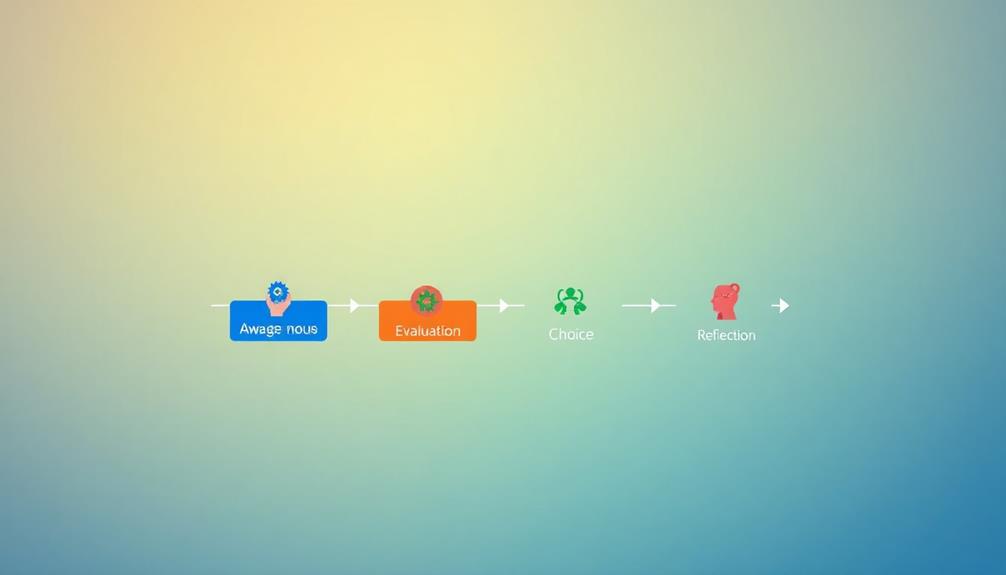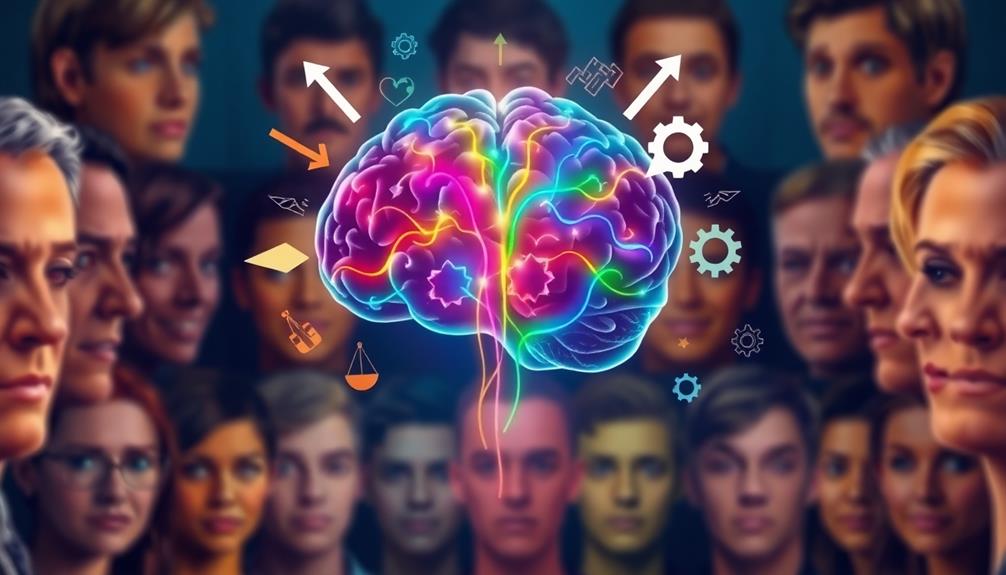To master decision-making cues that guide your audience, start by understanding their demographics and psychographics. Recognize which stage of decision-making they're in—be it awareness, evaluation, or purchase. Use emotional appeals and social proof during evaluation to build trust. Keep in mind how psychological factors like cognitive biases and emotional states can sway their choices. Additionally, engage effectively by tailoring your messages, maintaining eye contact, and using visual aids. Your ability to connect culturally will also enhance understanding. Take these insights further, and you'll discover even more strategies to boost your influence.
Key Takeaways
- Understand your audience's demographics and psychographics to tailor your message effectively and enhance engagement.
- Build trust during the awareness stage by providing valuable educational content rather than sales pitches.
- Utilize emotional appeals and social proof, like testimonials, to alleviate doubts during the evaluation stage.
- Address cognitive biases by framing information positively to influence perceptions and decision-making.
- Employ active listening and reflective feedback to strengthen rapport and guide your audience's choices.
Understanding Your Audience

Understanding your audience is essential for effective communication. By grasping audience demographics—like age, gender, income, and education level—you can tailor your messages to resonate with their specific needs.
In the context of education, leveraging data analytics can further enhance your understanding, as predictive modeling enhances decision-making through data analysis that identifies at-risk students and their needs.
But it doesn't stop there. Psychographics, which include interests, values, and lifestyles, considerably shape how your audience perceives your communication efforts.
You can gain valuable insights into audience preferences and behaviors through surveys and focus groups, enabling you to create content that truly connects. Utilizing audience personas helps you identify the varying decision-making processes within your audience, ensuring your content is targeted and engaging for each segment.
Don't overlook the impact of cultural influences, either. Recognizing these factors enhances your empathy and understanding in audience interactions, allowing you to communicate more effectively.
When you understand your audience, you're not just throwing messages into the void; you're crafting communications that speak directly to them, addressing their concerns and desires. This foundational knowledge empowers you to engage meaningfully, making a lasting impression and guiding your audience through their decision-making processes with confidence.
Stages of Decision-Making

Every interaction you have with your audience aligns with their decision-making journey, which unfolds in distinct stages: awareness, evaluation, and purchase. Understanding these stages helps you craft effective communication strategies that guide your audience through the decision-making process.
| Stage | Key Focus |
|---|---|
| Awareness | Build trust through educational content and general information. |
| Evaluation | Use emotional appeals and social proof, like testimonials, to help them compare options. |
| Purchase | Emphasize clear benefits and direct calls to action to ease their commitment. |
In the awareness stage, your audience looks for information about their problems, so avoid sales pitches. Instead, provide valuable insights that establish credibility. During evaluation, they weigh different solutions, so address their concerns and highlight advantages. Including testimonials can alleviate doubts and bolster trust. Finally, when it's time for purchase, your audience is ready to commit. Here, sales-centric content becomes appropriate, focusing on reassurance and clear benefits to facilitate their decision-making.
Recognizing the specific needs of your audience at each stage is essential for guiding them toward informed choices and enhancing overall satisfaction.
Psychological Influences on Choices

Decision-making isn't just a logical process; it's deeply influenced by psychological factors that can sway your choices in unexpected ways. For instance, cognitive biases like loss aversion can lead you to prioritize avoiding losses over acquiring gains, altering how you make decisions.
Additionally, stress management techniques, such as mindfulness practices, can help clear mental clutter, allowing for more rational decision-making mindfulness practices. Your emotional state also plays a significant role—positive emotions may encourage you to take risks, while negative emotions can make you more cautious.
The framing effect demonstrates how the same information can lead to different choices depending on its presentation. You might view a 90% survival rate more favorably than a 10% mortality rate, even though both convey the same statistic.
Heuristics, or mental shortcuts, help simplify complex ideas but can also lead to errors, like overestimating the likelihood of events based on vivid memories.
Cultural Impact on Decisions

Cultural norms shape how you approach choices, influencing your preferences and behaviors in ways that can be both subtle and profound. Understanding these influences is essential for effective decision-making. Engaging with diverse cultures not only broadens your perspective but also enhances empathy, helping you connect with others on a deeper level.
| Cultural Factor | Influence on Decision-Making |
|---|---|
| Communication Style | Determines how you express and receive ideas |
| Values and Beliefs | Shapes what you prioritize in your choices |
| Group Dynamics | Encourages collaborative efforts and innovation |
Strategies for Effective Engagement

Effective engagement is key to successful decision-making. To truly connect with your audience, start by making eye contact. This simple act fosters trust and shows that you value their presence.
Understanding demographics and psychographics helps tailor your message, as personalized communication can boost engagement by up to 74%. Additionally, consider how audience preferences, such as those for local or sustainable products like coffee, can inform your approach and enhance relatability, especially when discussing ethical sourcing practices.
When addressing a group, structure your presentation with a clear agenda. This clarity enhances retention and keeps your audience focused. Don't forget to incorporate opportunities for interaction; asking questions or encouraging discussion can further engage them.
Use active listening techniques like reflective feedback to acknowledge concerns, which strengthens rapport. Also, employ persuasive techniques that balance ethos, pathos, and logos. By addressing emotional influences, you increase the likelihood of buy-in from your audience.
Lastly, remember that 65% of individuals are visual learners. Utilize high-quality visuals and concise messaging to make your ideas resonate.
Frequently Asked Questions
How to Master Decision-Making?
To master decision-making, you need to understand the stages: awareness, evaluation, and choice. Recognize biases, simplify options, reflect on your values, and use structured tools to enhance clarity and confidence in your decisions.
What Are the Guides to Decide Decision-Making?
When faced with countless choices, you're swimming in a sea of options! To decide effectively, focus on your awareness, evaluate your options, understand biases, limit choices, and embrace diverse perspectives for clarity and satisfaction.
What Are the 7 Decision-Making Skills?
To make effective decisions, you need critical thinking, problem-solving, emotional intelligence, risk assessment, adaptability, collaboration, and creativity. These skills empower you to analyze situations, generate solutions, and navigate challenges successfully in any environment.
What Are the 5 Steps of Decision-Making?
The five steps of decision-making are identifying the problem, gathering information, evaluating alternatives, making the choice, and reviewing the decision. Each step's essential for ensuring you make informed and effective choices.
Conclusion
By mastering decision-making cues, you can connect with your audience on a deeper level. Remember, understanding their unique perspectives and motivations is like holding a compass that guides your message. As you engage with them, consider the psychological and cultural influences that shape their choices. When you tailor your strategies accordingly, you create a powerful dialogue that resonates. So, step into their shoes and watch your influence grow as you lead them toward informed decisions.










